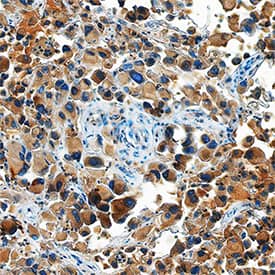Ephrin-A5 Products
There are two structural groups of ephrin ligands which bind to a family of receptor tyrosine kinases (Eph). A-type ephrins bind A-type receptors, which are tethered to the cell membrane via a glycosylphosphatidylinositol (GPI) anchor. B-type ephrins bind to B-type receptors, which have a single transmembrane domain and a cytoplasmic region. All ephrin ligands share a conserved extracellular sequence, which most likely corresponds to the receptor binding domain. This conserved sequence consists of approximately 125 amino acids and includes four invariant cysteines.
Only membrane bound or Fc-clustered ephrin ligands are capable of activating the receptor in vitro. Soluble monomeric ephrin ligands bind the receptor but do not induce receptor autophosphorylation and activation. In vivo, ephrin ligands and receptors display reciprocal expression. It has been found that nearly all ephrin receptors and ligands are expressed in developing and adult neural tissue. The Eph/ephrin families also appear to play a role in angiogenesis and synapse formation.
44 results for "Ephrin-A5" in Products
44 results for "Ephrin-A5" in Products
Ephrin-A5 Products
There are two structural groups of ephrin ligands which bind to a family of receptor tyrosine kinases (Eph). A-type ephrins bind A-type receptors, which are tethered to the cell membrane via a glycosylphosphatidylinositol (GPI) anchor. B-type ephrins bind to B-type receptors, which have a single transmembrane domain and a cytoplasmic region. All ephrin ligands share a conserved extracellular sequence, which most likely corresponds to the receptor binding domain. This conserved sequence consists of approximately 125 amino acids and includes four invariant cysteines.
Only membrane bound or Fc-clustered ephrin ligands are capable of activating the receptor in vitro. Soluble monomeric ephrin ligands bind the receptor but do not induce receptor autophosphorylation and activation. In vivo, ephrin ligands and receptors display reciprocal expression. It has been found that nearly all ephrin receptors and ligands are expressed in developing and adult neural tissue. The Eph/ephrin families also appear to play a role in angiogenesis and synapse formation.
| Source: | NS0 |
| Accession #: | P52803 |
| Applications: | Bind |
| Reactivity: | Human |
| Details: | Goat IgG Polyclonal |
| Applications: | WB, IHC |
| Source: | NS0 |
| Accession #: | NP_997537 |
| Applications: | BA |
| Reactivity: | Human, Mouse |
| Details: | Rabbit IgG Polyclonal |
| Applications: | WB, ICC/IF |
| Reactivity: | Human |
| Details: | Goat IgG Polyclonal |
| Applications: | WB |
| Source: | NS0 |
| Accession #: | P52803 |
| Applications: | Bind |
| Applications: | ELISA |
| Reactivity: | Human |
| Details: | Mouse IgG2a Kappa Monoclonal Clone #1F12 |
| Applications: | WB, ELISA |
| Reactivity: | Human |
| Details: | Mouse IgG2a Kappa Monoclonal Clone #1A2 |
| Applications: | WB, ELISA |
| Applications: | WB |
| Reactivity: | Mouse |
| Details: | Rabbit IgG Polyclonal |
| Applications: | IHC |
| Applications: | AC |
| Reactivity: | Mouse |
| Details: | Rabbit IgG Polyclonal |
| Applications: | IHC |
| Reactivity: | Mouse |
| Details: | Rabbit IgG Polyclonal |
| Applications: | IHC |
| Reactivity: | Mouse |
| Details: | Rabbit IgG Polyclonal |
| Applications: | IHC |
| Reactivity: | Mouse |
| Details: | Rabbit IgG Polyclonal |
| Applications: | IHC |
| Reactivity: | Mouse |
| Details: | Rabbit IgG Polyclonal |
| Applications: | IHC |
| Reactivity: | Mouse |
| Details: | Rabbit IgG Polyclonal |
| Applications: | IHC |
| Reactivity: | Mouse |
| Details: | Rabbit IgG Polyclonal |
| Applications: | IHC |
| Reactivity: | Mouse |
| Details: | Rabbit IgG Polyclonal |
| Applications: | IHC |
| Reactivity: | Mouse |
| Details: | Rabbit IgG Polyclonal |
| Applications: | IHC |
| Reactivity: | Mouse |
| Details: | Rabbit IgG Polyclonal |
| Applications: | IHC |
| Reactivity: | Mouse |
| Details: | Rabbit IgG Polyclonal |
| Applications: | IHC |
| Reactivity: | Mouse |
| Details: | Rabbit IgG Polyclonal |
| Applications: | IHC |
| Reactivity: | Mouse |
| Details: | Rabbit IgG Polyclonal |
| Applications: | IHC |




![Immunocytochemistry/ Immunofluorescence: Ephrin-A5 Antibody [NBP2-58251] Immunocytochemistry/ Immunofluorescence: Ephrin-A5 Antibody [NBP2-58251]](https://resources.bio-techne.com/images/products/Ephrin-A5-Antibody-Immunocytochemistry-Immunofluorescence-NBP2-58251-img0001.jpg)
![ELISA: Human Ephrin-A5 ELISA Kit (Colorimetric) [NBP2-82488] - Human Ephrin-A5 ELISA Kit (Colorimetric)](https://resources.bio-techne.com/images/products/nbp2-82488_human-ephrin-a5-elisa-kit-colorimetric-132202416173477.jpg)
![Western Blot: Ephrin-A5 Antibody (1F12) [H00001946-M01] Western Blot: Ephrin-A5 Antibody (1F12) [H00001946-M01]](https://resources.bio-techne.com/images/products/Ephrin-A5-Antibody-1F12-Western-Blot-H00001946-M01-img0005.jpg)
![Western Blot: Ephrin-A5 Antibody (1A2) [H00001946-M02] Western Blot: Ephrin-A5 Antibody (1A2) [H00001946-M02]](https://resources.bio-techne.com/images/products/Ephrin-A5-Antibody-1A2-Western-Blot-H00001946-M02-img0001.jpg)
![Western Blot: Ephrin-A5 Overexpression Lysate [NBL1-10145] Western Blot: Ephrin-A5 Overexpression Lysate [NBL1-10145]](https://resources.bio-techne.com/images/products/Ephrin-A5-Overexpression-Lysate-Adult-Normal-Western-Blot-NBL1-10145-img0002.jpg)
![Immunohistochemistry-Paraffin: Ephrin-A5 Antibody [NBP2-98318] Immunohistochemistry-Paraffin: Ephrin-A5 Antibody [NBP2-98318]](https://resources.bio-techne.com/images/products/Ephrin-A5-Antibody-Immunohistochemistry-Paraffin-NBP2-98318-img0001.jpg)
